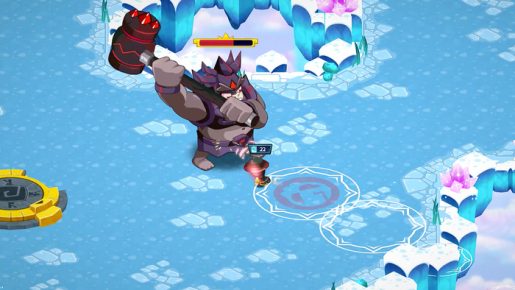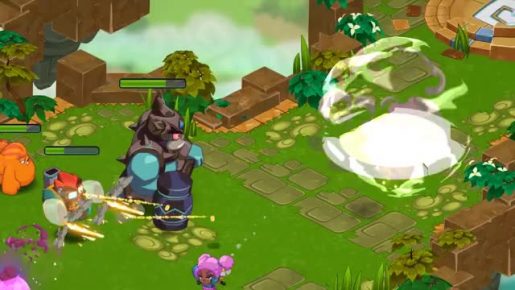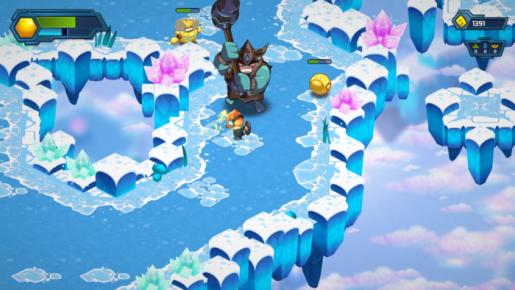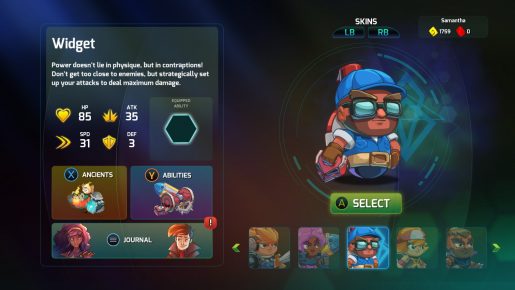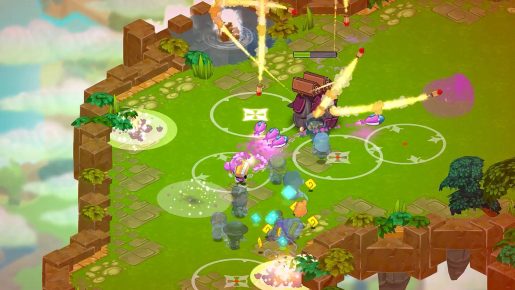Some of the best games are the ones that take simple concepts and find a way to make them exciting. There is nothing that makes something like Spelunky special. There are a couple rooms, few noteworthy traps and it all comes down to gaining the skill to deal with any and all problems. Next Up Hero works in a similar way. Every character plays a specific way and the trick is to figure out how to progress. Sometimes it will work, other times it won’t, with it all being worthwhile if you learn from your previous mistakes. With an intriguing concept, multiplayer and a variety of characters to use, is it the next big thing or all fluff and no substance.
There isn’t much story in Next Up Hero. Basically, two people find a mysterious location and use their ability to figure out what is going on. It’s a hard story to be interested in, if only for the fact it’s told through dialogue interactions between levels. If nothing else, it often feels out of place because there is no sense of progression, a core problem for Next Up Hero.
Simply put, no matter what you do, you’ll make some kind of progress in Next Up Hero. Instead of real objectives, such as finish an easy dungeon or create one of your own, progress is made by finishing levels, killing enemies, collecting tokens and gaining experience. This last one stands out the most, since story progression is tied to player level, so it isn’t defeating a fearsome foe or overcoming an impressive obstacle, but rather, collecting however many points between levels.
Character progress is also tied to this, with levels unlocking additional abilities and slots for equipment. Players may also pay a one-time fee, one that increases with each unlock, to gain an additional move. Said ability depends on the player, with some being useful and others being irrelevant, a problem that also occurs with equipment and abilities.
Equipment comes from progress, typically related to penultimate stages, boss battles, rare enemies and things of the like. The value seems to come from luck and difficulty, with the lowest tier being, at best, an absolute joke. For instance, the three attack items I have all have the value of 1 for attack, speed and/or HP. To put it into perspective, the lowest base attack is 25, speed is 27 and the highest HP is 300.
Needless to say, an increase between .33 and 4 percent is negligible. While some might argue 4 percent can make a difference, it has the same issue Bungie faced during level enabled Iron Banner. Even if there is an increase and it’s substantial, it only makes an impact when there is a decrease in the number of hits needed. Even if there are certain characters and situations where this is achieved, they’re not common enough to actually create a different experience. The only stat that seems to greatly benefit from, at least early items, is defense, with 1 defense being, in some cases, a 50 percent increase in defense.
Sadly, similar things can be said about abilities. These are unlocked by killing enemies and collecting uncommon items called tokens. Harder and rarer monsters have better abilities, with the actual quality depending on who and how you play. So, a rapid attacker benefits from low chance moves, such as stun, with melee finding value in things like traps appearing under you. Ignoring annoying things like there being four different stun abilities, higher tier enemies are simply outright better. Maxed out stun is worse than starting advanced stun, with the surprisingly easier to unlock expert stun yielding similar results, with master stun being absurdly strong. It isn’t a problem that things work this way, though, due to everything being a drop, players can pinpoint certain enemies and chase after their tokens and ignore lower tiers.
As far as actual gameplay goes, every character has a set play style, so players need to figure out who works best. Objectively I’d say any melee character is harder than ranged and would say some characters, such as Mixtape, are significantly easier to play and master. In his case, his only attack is rapidly firing his guns, with the special attack giving penetration and increasing his rate of fire and his paid attack giving homing rockets.
Needless to say, levels essentially come down to holding down the trigger and keeping your range. There are very few enemies that can overcome this tactic and the few that do are cheap in their own way (extremely fast speed, teleporting, etc). All of this would be okay if there were deeper mechanics at play but there isn’t.
After you pick one of the determined control styles, none of which are great, you’ll quickly learn there is only so much you can do to mitigate damage. Unlike Enter the Gungeon, where you can dodge and use things to your advantage, you either kill the enemy, use your dodge, with it’s two or three second cooldown, or take damage. Even this would be fine, except there is no healing outside of very specific circumstances, such as co-op player helping you. So, if you make a mistake on level one and take a hit that drops you to 40 percent, odds are you’ll have 60 percent health for the rest of that run.
Since so many things are set in stone, every run is dictated by how the dungeon is created, rather than player choice. I can go in with what I assume is the best build, something that is pretty easy to figure out due to the limited number of locations and enemies, so unless the modifier is bad (everyone has 1 hp, falling rocks, etc) or you happen to fight an enemy you can’t deal with, every run feels exactly the same. Even with a number of perks, such as stun, it doesn’t change the experience, as much as increase your likelihood of surviving.
Verdict
Despite the largely negative review, Next Up Hero can be fun, it’s just a very monotonous gameplay loop. All roads involve killing the same enemies, at the same locations, under the same handful of modifiers, to get resources that allow you to do the same thing, just at higher numbers. In a lot of ways, it seems like a fantastic title for the Switch. The idea of finishing a couple levels on the go or slowly chipping away at things works better on a portable console than a home one. But, in the end, Next Up Hero has some interesting ideas, such as using fallen players, including yourself, to help everyone finish the level (everyone who tries is also rewarded if it is successfully completed), it just ends up being an experience that is very simple. If this sounds appealing, odds are you’ll likely have a lot of fun, where as if you want something closer to Issac or Gungeon, look elsewhere.
[Editor’s Note: Next Up Hero was reviewed on PS4 platform. The game was provided to us by the publisher for review purposes.]

